To view this message as a file click here
To view the data as a file click here
- In the second quarter of 2023, the balance of the public’s financial assets portfolio increased by approximately NIS 117 billion (2.7 percent), to about NIS 5 trillion.
- The increase in the portfolio’s value in the second quarter was mainly due to increases in the balance of investments abroad (8.1 percent) and in the balance of equities in Israel (7 percent), in view of increases in equity indices in Israel and abroad, and in the balance of tradable corporate bonds (3 percent).
- The balance of the asset portfolio managed by institutional investors increased in the second quarter by approximately NIS 94 billion (4 percent), to about NIS 2.42 trillion at the end of the quarter.
- Institutional investors’ rate of exposure to foreign currency increased by about 1.1 percentage points during the quarter, to about 19.9 percent, while their exposure to foreign assets increased by about 1.6 percentage points, to about 41.9 percent.
- The value of the portfolio managed by mutual funds in Israel increased by about NIS 31 billion (8.4 percent) in the second quarter, to about NIS 403 billion. There were net new investments mainly in shekel money market funds.
1. The public’s total assets portfolio
In the second quarter of 2023, the balance of the public’s financial assets portfolio increased by approximately NIS 117 billion (2.7 percent), to about NIS 5 trillion (Figure 1). The weight of the public’s financial assets portfolio relative to GDP increased by about 2.8 percentage points, to about 273 percent at the end of the quarter, after declining since the beginning of 2022. This was a result of an increase in the asset portfolio that was greater than the increase in GDP.
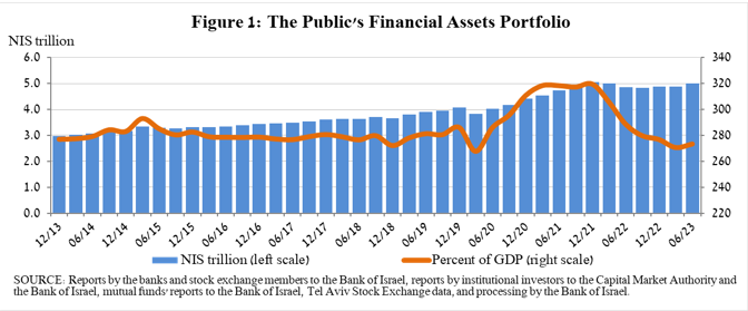
2. Analysis of the changes in the overall portfolio
Over the course of the second quarter, there were increases in the balances of the public’s holdings in all components of the portfolio. The increases in the balance of investments abroad (8.1 percent), the balance of equities in Israel (7 percent), and the balance of tradable corporate bonds (3 percent) were notable.

- The balance of equities in Israel increased by about NIS 44 billion (7 percent), in view of price increases on equity indices, which were slightly offset by net realizations.
- The balance of tradable corporate bonds in Israel increased by about NIS 11 billion, to about NIS 380 billion at the end of the quarter. This was a result of price increases, which were partly offset by net realizations (estimated at about NIS 3.2 billion).
- The balance of cash and deposits increased during the second quarter by about NIS 11.5 billion (0.6 percent) to about NIS 1.98 trillion.
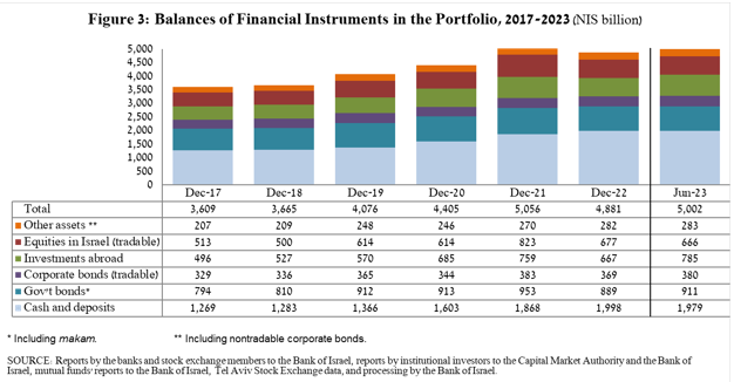
The balance of investments abroad increased by approximately NIS 58 billion (8.1 percent) during the quarter, to about NIS 785 billion, constituting about 16 percent of the total asset portfolio. The increase derived from the following two components:
- The balance of equities held abroad increased by about NIS 42 billion (1 percent), to about NIS 563 billion. This was mainly the result of a combination of price increases, net investments (estimated at about NIS 2.3 billion), and the depreciation of the shekel against the US dollar (2.4 percent).
- The balance of tradable (corporate and government) bonds abroad increased by about NIS 16 billion (8 percent) during the quarter, to about NIS 222 billion. This increase derived mainly from net investments totaling about NIS 10.6 billion, alongside the depreciation of the shekel against the US dollar (2.4 percent).
As a result of developments during the quarter, there was an increase of about 0.8 percentage points (from 14.9 percent to 15.7 percent) in the share of foreign assets, and an increase of about 0.2 percentage points (from 23.4 percent to 23.6 percent) in the share of foreign currency assets.
3. The portfolio managed by institutional investors[1]
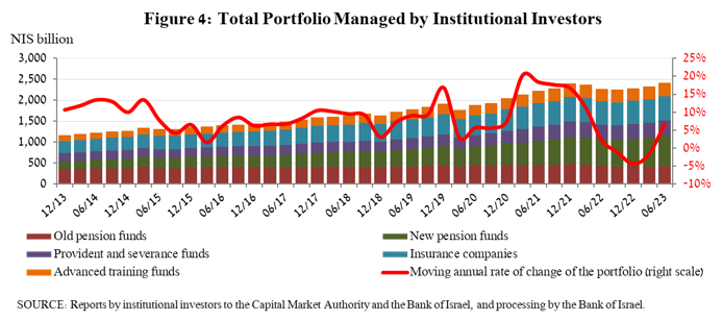
- The balance of assets managed by all institutional investors increased in the second quarter by about NIS 94 billion (4 percent), to about NIS 2.42 trillion (about 48 percent of the public’s total financial assets portfolio). The increase in the balance encompassed all institutional investors. The increase in the balance of the managed portfolio during the quarter was mainly due to changes in the following investment components: equities abroad—an increase of about NIS 12.5 billion (8.6 percent), mainly due to price increases; bonds abroad—an increase of about NIS 8.4 billion (10.5 percent), mainly as a result of net purchases; equities in Israel—an increase of about NIS 7.6 billion (3.7 percent), mainly due to price increases; and corporate bonds in Israel—an increase of about NIS 7.2 billion (4.1 percent) due to net purchases and price increases.
- Exposure of the portfolio managed by institutional investors[2] to foreign assets and to foreign currency
In the second quarter of 2023, the rate of institutional investors’ exposure to foreign assets increased by about 1.6 percentage points, to about 41.9 percent of total assets. This was a result of an increase in the balance of exposure to foreign assets (5.7 percent) that was greater than the increase in the balance of institutional investors’ total assets (1.6 percent) in dollar terms.
The increase in the balance of exposure to foreign assets (about $14.2 billion) derived from an increase in the balance of equities abroad (about $4.8 billion), exposure through futures contracts and options on foreign equity indices (about $3.1 billion), an increase in the balance of foreign bonds (about $2.3 billion), and an increase in investment funds abroad (about $2.1 billion).
Exposure to foreign currency—During the second quarter of 2023, institutional investors made net purchases of foreign currency assets, totaling about $0.2 billion—purchases totaling about $1.5 billion in assets denominated in and linked to foreign currency (mainly in foreign bonds, while selling demand deposits in Israel denominated in foreign exchange, and futures and options), which were mostly offset by net sales of foreign exchange through derivative financial instruments totaling about $1.3 billion, meaning an increase in futures transactions for the sale of foreign exchange.
During the second quarter, institutional investors’ rate of exposure to foreign exchange (including shekel/forex derivatives) increased by about 1.1 percentage points to about 19.9 percent, due to an increase in the rate of exposure to foreign exchange after hedging that was greater than the increase in total investment assets in dollar terms.
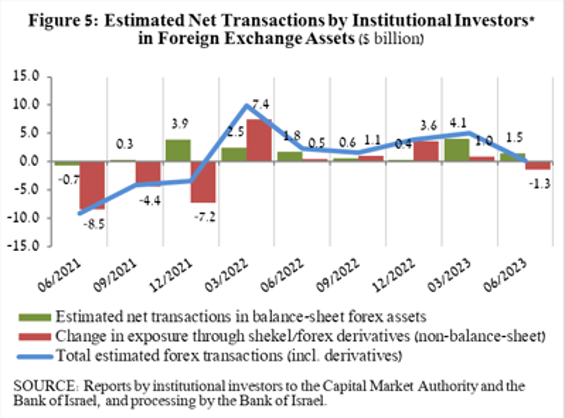
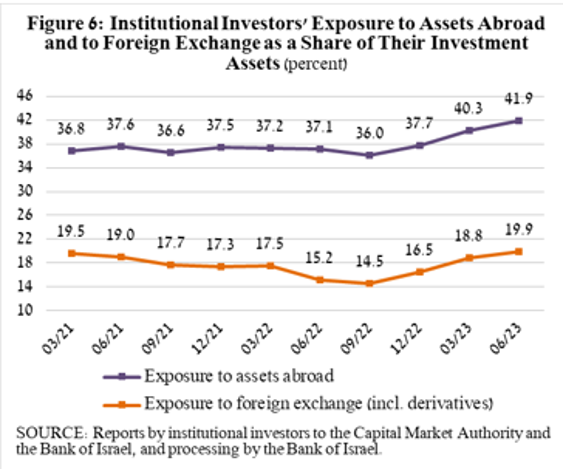
4. The portfolio managed by mutual funds
The value of the portfolio managed by Israeli mutual funds increased in the second quarter by about NIS 31 billion (8.4 percent), to about NIS 403 billion, constituting about 8 percent of the public’s total asset portfolio.
The increase in the second quarter derived mainly from net investment in the funds totaling about NIS 15 billion. Most of the new investment was in shekel money market funds, totaling NIS 11.5 billion, further to the trend since the beginning of 2022. In contrast, there were net withdrawals of NIS 3.5 billion from funds specializing in general bonds in Israel.
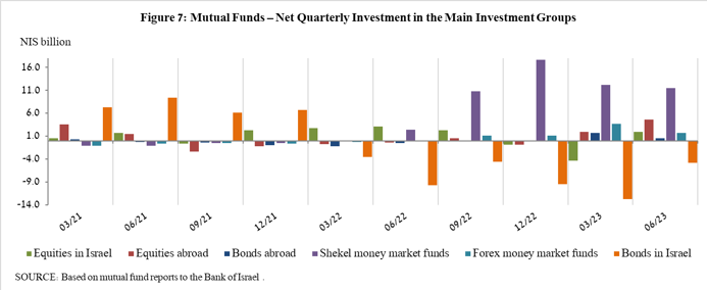
Further information and details:
Long-term tables on the asset portfolio are available here.
Long-term tables on institutional investors’ exposure to foreign exchange and to foreign assets are available here.
Long-term tables on mutual funds are available here.
[1] Excluding mutual funds.
[2] Estimates of members’ exposure (rather than exposure of the institutional investors themselves) to various risks in the portfolio managed for them by the institutional investors (excluding insurance policies with a guaranteed yield, where the risk is taken on by the institutional investors). For additional details on definitions, terms, and explanations, see “Measuring the Exposures of Institutional Investors to Foreign Currency and to Foreign Assets” in the Bank’s Statistical Bulletin for 2016.